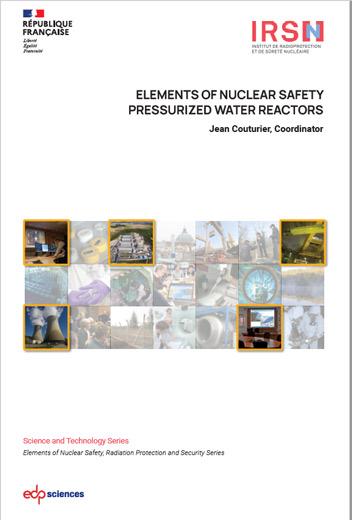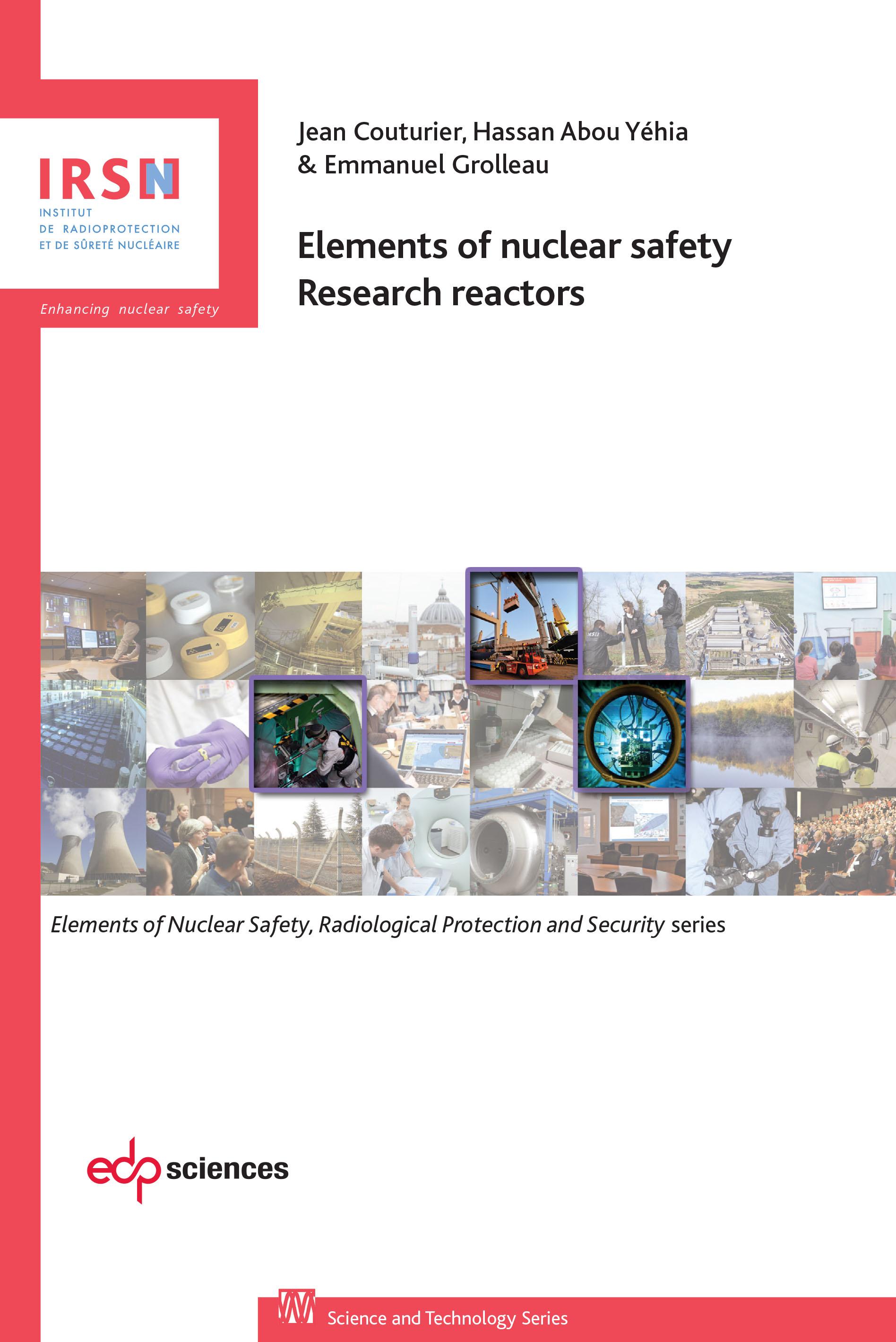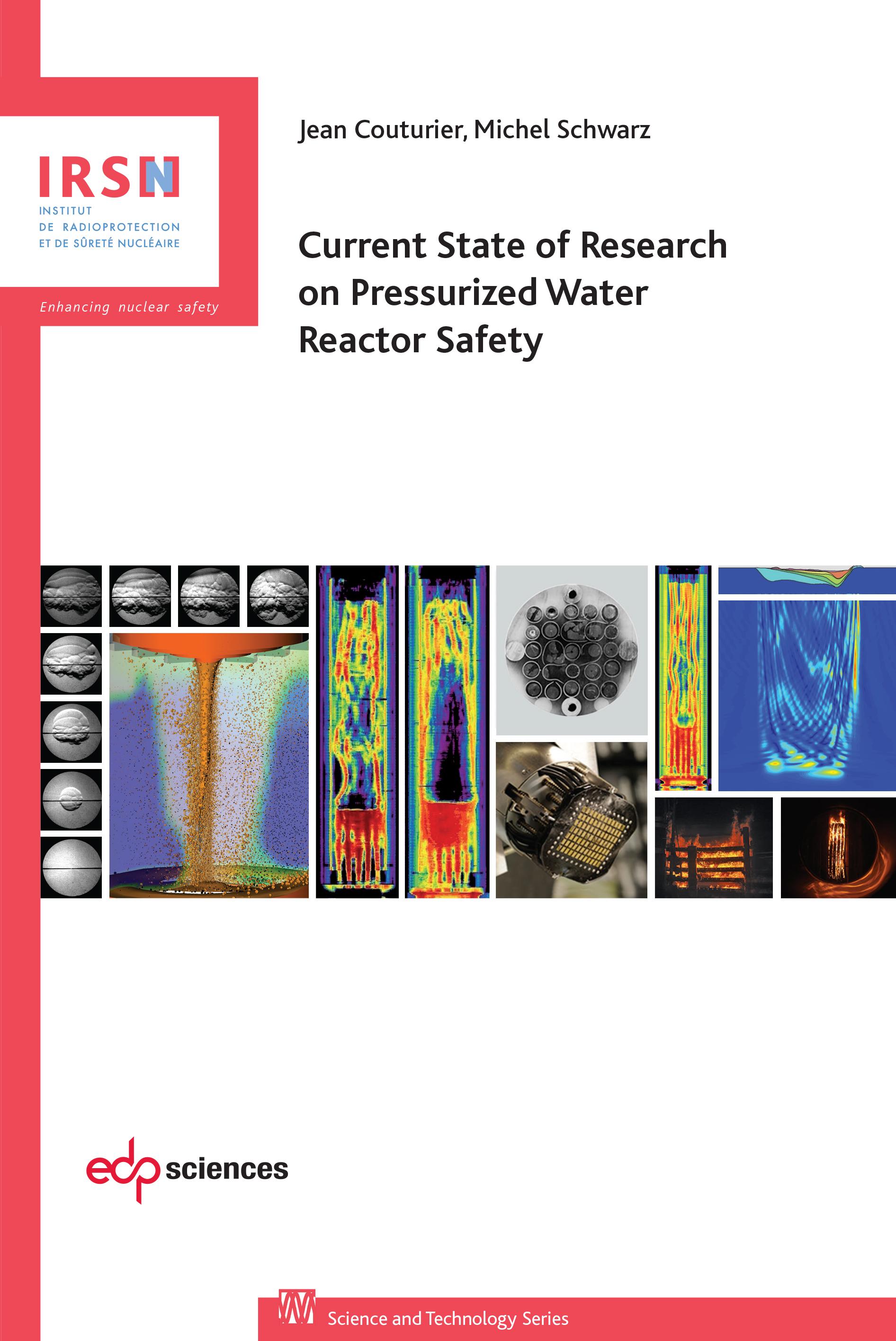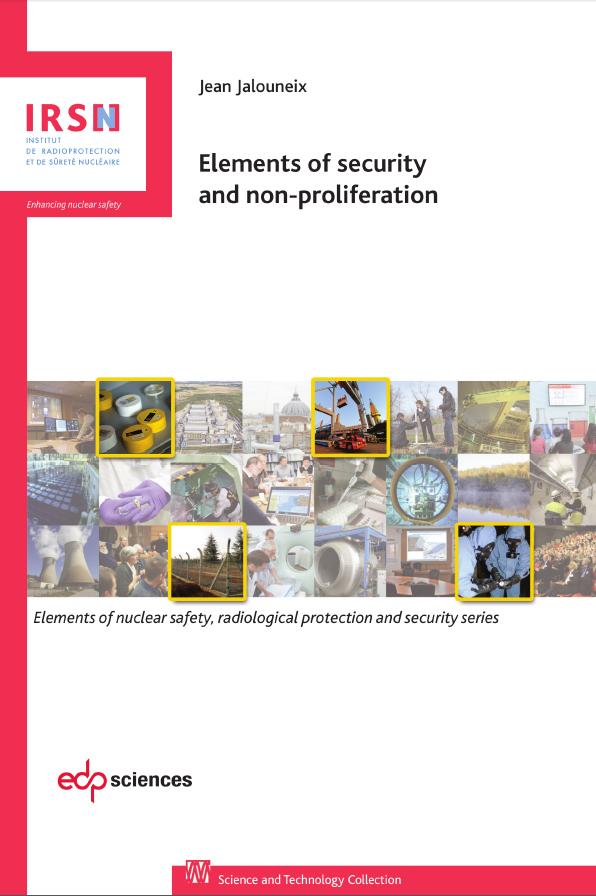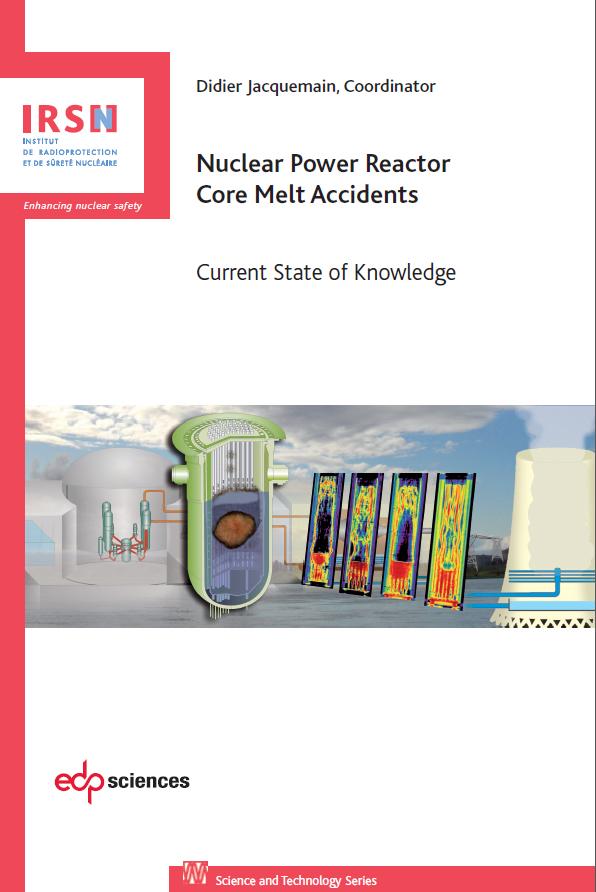Science and Technology Series
The Science and Technology Series includes monographs and overviews of current knowledge on radiological protection and nuclear safety. These books are written for the most part by IRSN authors with the participation of one or several outside authors and coordinated by an IRSN researcher or specialist. A Reading Committee monitors their quality.
Elements of nuclear safety - Pressurized water reactors
Coordinator and Senior Writer : Jean Couturier
Number of pages : 1170
Format : H 24 cm x L 16 cm
Year of publication : 2022
Available languages : English
The book narrates the determined and continuous quest to enhance nuclear safety. jean Couturier, coordinator and senio editor, covers the forty-year history of evolution in the safety objectives, approaches, analysis methods and assessment criteria that have defined pressurized water reactor safety, mainly within the French nuclear power plant fleet, from the 1970s up to today's Flamanville 3 EPR.
Everyone, including current and future generations of engineers, researchers and, more broadly, any citizen interested in nuclear safety issues will find that book reinforces their knowledge on this important subject, providing an understanding for the fundamentals, to the benefit of nuclear and radiological risk control.
Elements of nuclear safety - Research reactors
Author : J. Couturier, H. Abou Yéhia, E. Grolleau
Number of pages : 253
Format : H 24 cm x L 16 cm
Date of issue : 2019
Available language : English
Price: 35€
This publication gives a global overview of the diversity and complementarity of research reactors, some of which have been or are still being used to conduct experiments that are essential for the development and operation of nuclear power reactors, including in relation to safety issues.
This work highlights the many uses of these reactors, which have very different designs, use highly varied quantities of radioactive substances with varying levels of risk for safety and radiation protection, and which — in many cases because they are old or have been shut down — require appropriate measures to control the ageing or obsolescence of some of their equipment, as well as, on an organisational and human level, to ensure that they continue to be operated safely.
For some research reactors, safety and radiation protection aspects must be considered, taking into account that two types of operators are present at the same time within these reactors: reactor operating personnel and operators in charge of experimental devices using neutrons from the reactor for fundamental or applied research purposes.
There are two specific chapters on the safety standards established under the aegis of the IAEA for research reactors and on serious accidents, notably those involving criticality and reactivity, in research reactors. The second part of the work focuses on French research reactors, including the regulations and official documents applicable to these reactors, on lessons learned in France from significant events and accidents — as well as abroad, such as the Fukushima Daiichi nuclear power plant accident in 2011 — on the consideration of reactivity accidents in the design of French research reactors, and on the ten-yearly safety reviews carried out in France.
Current state of research on pressurized water reactor safety
Author : J. Couturier, M. Schwarz
Format : H 24 cm x L 16 cm
Date of issue : 2017
Available language : English
Price : 35 €
For more than 40 years, IPSN then IRSN has conducted research and development on nuclear safety, specifically concerning pressurized water reactors, which are the reactor type used in France.
This publication reports on the progress of this research and development in each area of study - loss-of-coolant accidents, core melt accidents, fires and external hazards, component aging, etc. -, the remaining uncertainties and, in some cases, new measures that should be developed to consolidate the safety of today's reactors and also those of tomorrow.
A chapter of this report is also devoted to research into human and organizational factors, and the human and social sciences more generally. All of the work is reviewed in the light of the safety issues raised by feedback from major accidents such as Chernobyl and Fukushima Daiichi, as well as the issues raised by assements conducted, for example, as part of the ten-year reviews of safety at French nuclear reactors.
Finally, through the subjects it discusses, this report illustrates the many partnherships and exchanges forged by IRSN with public, industrial and academic bodies both within Europe and internationally. This publication reflects IRSN' desire to keep an enduring record of its results and to share its knowledge.
Elements of security and non-proliferation
Author : J. Jalouneix
Format : H 24 cm x L 16 cm
Date of issue : 2017
Available language : English
Price : 25 €
Following on from the work on the safety of nuclear facility published in 1996, which needed to be updated and extended in scope, IRSN has created a new series of educational publications entitled "Elements of nuclear safety, radiological protection and security". The series takes up the general objective of tackling all aspects of risk management in the nuclear field, in terms of protecting human health, society and the environment.
The first publication in this series, covering nuclear security and non-proliferation, describes the measures implemented in France and at international level to prevent terrorism and malicious acts and, if necessary, mitigate the consequences of any such act. It deals with the security of nuclear material, nuclear facilities and the transport of nuclear material, the security of radioactive sources and describes States' undertakings to implement safeguards relative to tracking nuclear material and chemicals to prevent their use for fraudulent purposes.
These publications will be of interest to anyone concerned by these issues, especially those who work in the nuclear industry, but it will also answer many questions that members of the public may have regarding these subjects. It includes information on context and history, the provisions and requirements contained in French regulations and international agreements, as well as details of the roles played by the various entities involved, including IRSN.
Nuclear power reactor core melt accidents. Current state of knowledge
Coordinator : D. Jacquemain
Authors : A. Bentaïb, H. Bonneville, G. Cénérino, B. Clément, F. Corenwinder, M. Cranga, G. Ducros, F. Fichot, D. Jacquemain, C. Journeau, V. Koundy, D. Leteinturier, D. Magallon, R. Meignen, F. Monroig, G. Nahas, F. Pichereau, E. Raimond, J-M. Seiler, B. Tourniaire, J-P. Van Dorsselaere
Number of pages : 414
Format : H 24 cm x L 16 cm
Date of issue : 2013
Available language : English
Price : free
For over thirty years, IPSN and subsequently IRSN has played a major international role in the field of nuclear power reactor core melt accidents through the undertaking of important experimental programmes (the most significant being the PHEBUS FP programme), the development of validated simulation tools (the ASTEC code that is today the leading European tool for modelling severe accidents), and the coordination of the SARNET (Severe Accident Research Network) international network of excellence. These accidents are described as "severe accidents" because they can lead to radioactive releases outside the plant concerned, with serious consequences for the general public and for the environment.
This book compiles the sum of the knowledge acquired on this subject and summarises the lessons that have been learnt from severe accidents around the world for the prevention and reduction of the consequences of such accidents, without addressing those from the Fukushima accident, where knowledge of events is still evolving.
The knowledge accumulated by the Institute on these subjects enabled it to play an active role in informing public authorithies, the media and the public when this accident occurred, and continues to do so to this day.
Radioactive fall-out in France from the Chernobyl accident - Environmental consequences and human exposure
Authors : P. Renaud, D. Champion, J. Brenot
Number of pages : 192
Format : H 24 cm x W 16 cm
Date of issue : 2008
Available language : French
Price : 35 €
For IRSN, the twentieth anniversary of the Chernobyl disaster provided an opportune moment to conduct a new assessment of radioactive fall-out in France caused by the accident. The book reports on knowledge acquired through numerous scientific studies conducted in France since its first edition was published in 1999. The new edition provides the most recent knowledge and assessments into the transfer of radioactive substances - released during the accident - into the air, soil and food.
This status report explains the levels of radioactive contamination levels observed in France between 1986 and 2006, before going on to assess the exposure of the French population to fall-out from the accident. Analysis of the Chernobyl accident illustrates the multitude and complexity of contamination phenomena and the transfer of radioactive substances from the environment to humans.
To conclude, this book presents the lessons learned from the disaster in terms of knowledge and with regards to the development of scientific programs, radiological monitoring and nuclear crisis management in France.
Nuclear Catastrophes and Accidents in the Former USSR
Coordinator : D. Robeau
Number of pages : 138
Format : H 24 cm x W 16 cm
Date of issue : 2001
Available language : French
Price : 30 €
For IRSN, the twentieth anniversary of the Chernobyl disaster provided an opportune moment to conduct a new assessment of radioactive fall-out in France caused by the accident. The book reports on knowledge acquired through numerous scientific studies conducted in France since its first edition was published in 1999. The new edition provides the most recent knowledge and assessments into the transfer of radioactive substances - released during the accident - into the air, soil and food.
This status report explains the levels of radioactive contamination levels observed in France between 1986 and 2006, before going on to assess the exposure of the French population to fall-out from the accident. Analysis of the Chernobyl accident illustrates the multitude and complexity of contamination phenomena and the transfer of radioactive substances from the environment to humans.
To conclude, this book presents the lessons learned from the disaster in terms of knowledge and with regards to the development of scientific programs, radiological monitoring and nuclear crisis management in France.
Uranium, from the environment to man
Coordinator : Henri Métivier
Number of pages : 340
Format : H 24 cm x W 16 cm
Date of issue : 2001
Available language : French
Price : 54 €
Since its discovery, more than 200 years ago by the chemist M.H. Klaproth, uranium has found numerous uses. At present, its use for energetic purposes positions it to the core of safety and protection problems controlled by the nuclear industry.
In this volume, uranium experts describe its presence in the environment, its chemistry, its development as a fuel element for reactors, but also its toxicity, the hazards for handlers and the rules implemented for using it.
The authors, from varied horizons and professions, bring a neutral and unpassionated look on what uranium is. The preface is written by Professor Robert Guillaumont, a member of the French Academy.
Caesium, from the environment to man
Coordinating authors : D. Robeau, F. Daburon and H. Métivier
Number of pages : 288
Format : H 24 cm x W 16 cm
Date of issue : 2000
Available language : French
Price : 53,35 €
Fourteen years after the Chernobyl accident, there is still caesium-137 in the soil in Europe and the experts expect it to remain there for decades. What are the properties of this radionuclide remaining so long after the accident? How does its presence vary in the soil, in water and in the food chain? What are the risks for people and the environment? And, above all, how can this unwanted nuclear waste be go rid of? These are some of the questions that the authors of the book answer.
The experts, of France and other countries, that have contributed in different ways to accumulating the knowledge presented here, and their long experience of the issues mentioned, are a guarantee the information is firsthand. The preface is by Jean Dercourt, life secretary of the French Academy of Science.
Nuclear installations and the environment: assessment method for the radioecological and dosimetric impact
Coordinating authors : L. Foulquier, F. Bretheau. With the collaboration Y. Baudin-Jaulent, A. Desprès,A. Lambrechts, J. Garnier-Laplace, M. Pally, B. Descamps, M. Masson, G. Gontier, H. Mansoux, L. Jourd’Heuil et F. Vray
Number of pages : 171
Format : H 24 cm x W 16 cm
Date of issue : 1998
Available language : French
Price : 38,10 €
Definition of the objectives and substance of radioactive nuclide measurements in the environment. The selection of the main components of the environment taken into account and the methods for taking, preparing and conditioning samples are given in detail.
The analyses to be carried out in estimating the radioecological impact of installations are clearly explained. The dosimetric impact for the population and the risks run are assessed using this radioecological impact.
Radon, from the environment to man
Coordinating authors : M.C. Robé, H. Métivier in conjunction with professionals of radon
Number of pages : 274
Format : H 24 cm x W 16 cm
Date of issue : 1998
Available language : French
Price : 53,35 €
At the same time as a new regulation has just been implemented, the best French specialists on radon explain the different properties of this gas in order to enable an unaware public to appreciate the risks that it may pose to the population.
Tritium, from the environment to man
Coordinating authors : Y. Belot, M. Roy and H. Métivier
Number of pages : 191
Format : H 24 cm x W 16 cm
Date of issue : 1996
Available language : French
Price : 38,10 €
Report on the knowledge acquired concerning tritium and examination of its developmentin the natural environment, its transfer to man and current emission reduction efforts.
Elements of nuclear safety
Coordinating author: J. Libmann
Number of pages: 574
Format: H 24 cm x W 16 cm
Date of issue: 1996
Available languages: French – English – Russian
Price: 53,35 € in French, 65 € in English and free of charge in Russian
Presentation of the bases, principles and experiments conducive to for those personsconcerned with the safety of nuclear installations. The author insists upon the gradual construction of safety and the difficulties encountered in France, despite the generally very satisfactory safety record of French installations.
He also deals with practical applications relating to calculating radiological consequences or the probability of some accidental sequences. Examples are thus available to enable the reader to get an idea of the scale of the phenomena. The clarity of the presentation brings it within reach of a general readership.
Nuclear plant safety approach
Author: J. Fauré
Number of pages: 250
Format: H 24 cm x W 16 cm
Date of issue: 1995
Available language: French
Price: 38,10 €
The selection of a site for the implantation of a nuclear installation is described with the aid of several illustrations. The educational approach enables the safety rules that are in application in France to be understood.
Treatment of workers subjected to accidental internal contamination
Authors: M.H. Bhattacharyya, , B.D. Breitenstein, B.A. Muggenburg, H. Métivier, G.N. Stradling et V. Volfu
Number of pages: 115
Format: H 24 cm x W 16 cm
Date of issue: 1995
Available language: French
Price: Distribution free of charge to the medical sector, upon request, subject to availability
Six internationally renowned experts, three Americans and three Europeans, describecurrent techniques for decontamination of persons who have absorbed radioactive nuclides.
The radioactive nuclide approach and medical treatment approach are dealt with, along with management of contaminated persons, training of medical personnel and the research still to be carried out.

